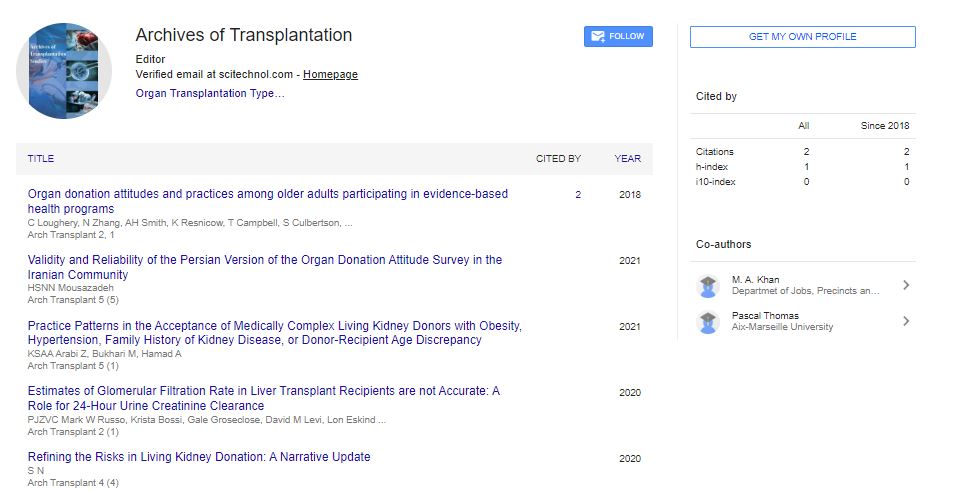Short Communication, Arch Transplant Vol: 7 Issue: 4
Examining the Mechanisms and Emerging Applications in Xenotransplantation
Bin Huiang*
1Department of Neurosurgery, Zhujiang Hospital of Southern Medical University, Guangdong, China
*Corresponding Author: Bin Huiang,
Department of Neurosurgery, Zhujiang
Hospital of Southern Medical University, Guangdong, China
E-mail: bin_huiang@zhsmu22.cn
Received date: 22 November, 2023, Manuscript No. AT-24-124984;
Editor assigned date: 24 November, 2023, PreQC No AT-24-124984 (PQ);
Reviewed date: 11 December, 2023, QC No. AT-24-124984;
Revised date: 19 December, 2023, Manuscript No. AT-24-124984 (R);
Published date: 26 December, 2023, DOI: 10.4172/AT.1000159
Citation: Huiang B (2023) Examining the Mechanisms and Emerging Applications in Xenotransplantation. Arch Transplant 7:4.
Description
Xenotransplantation, the transplantation of organs or tissues from one species to another, holds the potential of addressing the persistent shortage of human organs for transplantation. It delves into the intricate mechanisms of xenotransplantation and explores the emerging applications that are reshaping the landscape of organ transplantation [1]. At the core of xenotransplantation lies the ability to bridge the gap between species, primarily involving the transplantation of porcine organs into humans. The mechanisms behind successful xenotransplantation are complex, involving a thorough understanding of immunological challenges, genetic modifications, and the intricacies of organ compatibility [2].
One of the primary obstacles in xenotransplantation is the potential for hyper-acute rejection, a rapid and severe immune response against the transplanted organ. This reaction is triggered by pre-existing antibodies in the recipient's blood that recognize and attack antigens on the donor cells. Efforts to overcome this challenge involve genetic modifications of donor pigs to reduce the expression of antigens that provoke these immediate immune responses [3]. Genetic engineering plays a pivotal role in enhancing the compatibility of pig organs with the human immune system.
Anlaysts employ advanced techniques, including CRISPR-Cas9, to modify the pig's genome and eliminate or modify genes responsible for eliciting immune reactions. By introducing human genes into the pig's DNA or altering specific pig genes, experts aim to develop organs that are more compatible with the human immune system, minimizing the risk of rejection [4]. Successful xenotransplantation also hinges on achieving functional compatibility between donor pig organs and human recipients. Analysts focus on refining techniques to ensure the proper functioning of transplanted organs, addressing issues such as blood clotting, vascularization, and organ perfusion [5].
These advancements are essential for enhancing the overall success and longevity of xeno-transplanted organs. As xenotransplantation studies progresses, several emerging applications showcase its potential to revolutionize the field of organ transplantation. The most immediate and impactful application of xenotransplantation is its potential to address the severe shortage of human organs available for transplantation [6]. Pigs, with their physiological similarities to humans, offer a readily available and viable source of organs. If successful, xenotransplantation could significantly reduce waiting times for transplant recipients and save countless lives [7]. Xenotransplantation provides access to innovative therapies and disease modeling. The ability to introduce specific genetic modifications into pigs not only enhances organ compatibility but also provides a platform for studying human diseases.
Genetically modified pigs can serve as invaluable models for developing treatments for conditions ranging from diabetes to neurodegenerative disorders. The customizable nature of genetic modifications in xenotransplantation aligns with the principles of personalized medicine [8]. Tailoring donor organs to meet the unique genetic profiles of individual recipients has the potential to minimize the risk of rejection and improve the overall success rates of transplantation. This personalized approach may revolutionize how one can view and conduct organ transplants in the future. Despite the promising advancements, xenotransplantation faces significant challenges and ethical considerations. Concerns related to the potential transmission of zoonotic diseases, the long-term effects of genetic modifications, and the ethical treatment of animals involved in studies demand careful consideration and regulation [9,10].
Conclusion
In examining the mechanisms and emerging applications of xenotransplantation, it becomes evident that this field holds immense potential for transforming the landscape of organ transplantation. As studies unravel the complexities of immunological challenges, refine genetic modifications, and explore novel applications, xenotransplantation stands as a beacon of hope for addressing organ shortages and advancing the understanding of human diseases. While challenges and ethical considerations persist, the ongoing progress in xenotransplantation innovations signifies a bold stride toward a future where organ transplantation is more accessible, efficient, and tailored to the individual needs of patients.
References
- Nasralla D, Coussios CC, Mergental H (2018) A randomized trial of normothermic preservation in liver transplantation. Nature 557:50-56.
- Tubenitsky BM, Booster MH, Nederstigt AP, Kievit JK, Jacobs RW, et al. (1999) Kidney preservation in the next millenium. Transplant Int 12:83-91.
- Guibert EE, Petrenko AY, Balaban CL, Somov AY (2011) Organ preservation: current concepts and new strategies for the next decade. Transfus Med Hemotherapy 38:125-142.
[Google Scholar] [PubMed]
- Vogel T, Brockmann JG, Coussios C, Friend PJ (2012) The role of normothermic extracorporeal perfusion in minimizing ischemia reperfusion injury. Transplant Rev 26:156-162.
- St Peter SD, Imber CJ, Friend PJ (2002) Liver and kidney preservation by perfusion. The Lancet 359:604-613.
[Crossref]
- Vajdová K, Graf R, Clavien P (2002) ATP-supplies in the cold-preserved liver: A long-neglected factor of organ viability. Hepatol 36:1543-1552.
[Crossref] [Google Scholar] [PubMed]
- Hoogland EP, Snoeijs MG, van Heurn LE (2010) DCD kidney transplantation: Results and measures to improve outcome. Curr Opin Organ Transplant 15:177-182.
[Crossref] [Google Scholar] [PubMed]
- Ravikumar R, Leuvenink H, Friend PJ (2015) Normothermic liver preservation: A new paradigm? Transplant Int 28:690-699.
[Crossref] [Google Scholar] [PubMed]
- Hauet T, Eugene M (2008) A new approach in organ preservation: potential role of new polymers. Kidney Int 74:998-1003.
[Crossref] [Google Scholar] [PubMed]
- Jing L, Yao L, Zhao M, Peng LP, Liu M (2018) Organ preservation: from the past to the future. Acta Pharmacol Sin 39:845-857.
[Google Scholar] [PubMed]
 Spanish
Spanish  Chinese
Chinese  Russian
Russian  German
German  French
French  Japanese
Japanese  Portuguese
Portuguese  Hindi
Hindi 